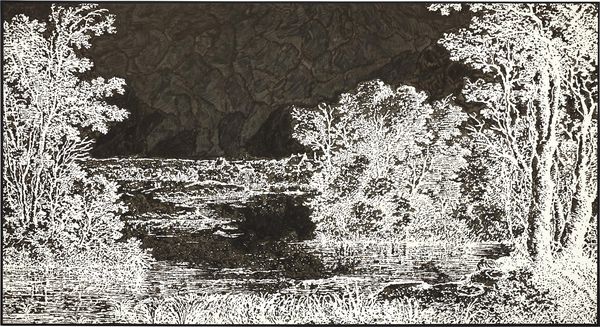Ugo Rondinone No. 69 VIERUNDZWANZIGSTERNOVEMBERNEUNZEHNHUNDERTFÜNFUNDNEUNZIG, 1995
Landscapes are at the root of my work…The whole of romantic imagery is in these landscapes. They portray a nostalgic view of time past.
— Ugo Rondinone
No. 69 VIERUNDZWANZIGSTERNOVEMBERNEUNZEHNHUNDERTFÜNFUNDNEUNZIG by Ugo Rondinone is emblematic of the artist's engagement with suspended time and space. His pulsing lines and wide strokes of fluid India ink contrast with diaphanous frontal detail to define an immersive, poetic environment.
Soaring, gathered mountains and delicate water and trees coalesce to form a serene landscape that is replete with references to both art historical tradition and contemporary commentary on the act of graphic creation. With a nod to Jan Brueghel the Elder's feathery trees and rivers, Fragonard's cloud-covered hills and John Constable's nineteenth-century ponds and gardens, Rondinone creates a monumental, monochrome landscape that unfolds lyrically in front of the viewer. Specifically calling to mind Rembrandt's celebrated black and white etchings, Rondinone modernizes the powerful yet ethereal effects of light and shade that the Dutch draughtsman reflected in drypoint and inks with a vivid three-part tonal structure: rich black at the deepest structural points and uniform charcoal grey in the middle give way to a luminescent white that evokes the piercing brightness of photographic negatives.
Epitomizing the artist's exploration of time, the work's German title lists without pause the date of its execution: "twentyfourthofnovembernineteenhundredninetyfive." As curator Alison Gingeras has noted for a Whitechapel Gallery exhibition catalogue in 2006, Rondinone's landscape works "are subjected to a ritualized time of production" as he likens "his practice to a series of devotional rituals." Making the passing of time manifest, No. 69 VIERUNDZWANZIGSTERNOVEMBERNEUNZEHNHUNDERTFÜNFUNDNEUNZIG is a powerful example in a striking scale of how Rondinone melds pictorial and linguistic poetry to heighten the experience of sensitive reflection.


